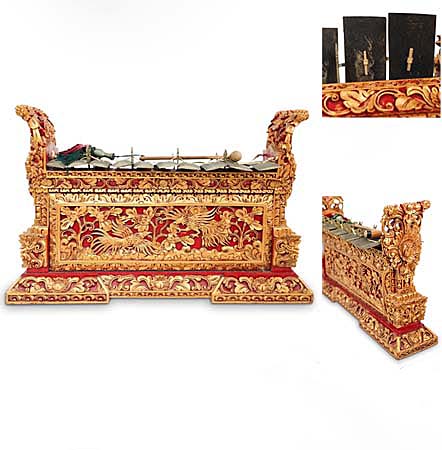
Owner: HWMC
Catalog#:2AS-IDST-72
Metallophones/Xylophones
Bali ‘Gangsa’ (Kantilan)
Bali, Indonesia
Balinese
Wood, metal, leather, paint, bamboo
Mid 20th century
Height: 17 in; Width: 9 in; Length: 26.5 in
Idiophones – Struck Idiophones – Metallophones/Xylophones
The Gamelan is the traditional Indonesian tuned ensemble of the Balinese, Javanese, and Sundanese, made up of gongs, xylophones, and various stringed and wind instruments. In Bali, there are several types of gamelan orchestras, the largest (with some 25 players) being the Gong Kebyar and Semar Pegulingan. At the beginning of the 20th century, they were distinctively different, however since then they have become more alike both in form and function. These ensembles are predominately made of bronze metallophones, called gangsa. Seen here is the highest pitched gangsa of Balinese Gamelan, called the kantilan. It is tuned to the pelog selisir scale and is used in the Gamelan gong kebyar style. The term kebyar means “to flare up or burst open.”
In the complete Balinese gamelan gong kebyar there typically would be nine gangsas of three different sizes and pitch registers, from the largest and lowest-pitched to the smallest and highest-pitched: ugal, pemade, and kantilan (smallest). Each of these varieties of gangsa has ten keys suspended over tuned-bamboo resonators and are tuned to a pentatonic scale over the range of two octaves. Of the nine gangsa in the kebyar style, there are four kantilans, two male and two female. Their highest note is around C7. The ten rectangular-shaped keys (don) are suspended by leather straps/rope and posts over tuned tube resonators (tiying or bumbung). These keys are made from bronze (krawang) and are played with a wooden hammer. Players often sit on the floor to play this instrument. The keys are graduated in size and are arranged in a horizontal plane from the longest, widest and thinnest one at one end of the case to the shortest, narrowest, and thickest one at the other end. Two holes are drilled in each key for the cords to feed through as the keys are suspended over a teakwood casing (plawah) and above cylindrical tube resonators (bumbung) made from bamboo (tiying), one for each of the instrument’s ten keys.
Though the ten-key gangsa-type instruments of the gamelan gong kebyar are an innovation of the early 20th century, they are actually a new variation on a centuries-old instrument type called the gendèr gantung (gendèr with hanging keys).
Reference: https://omekas.grinnell.edu/s/MusicalInstruments/item/3437
